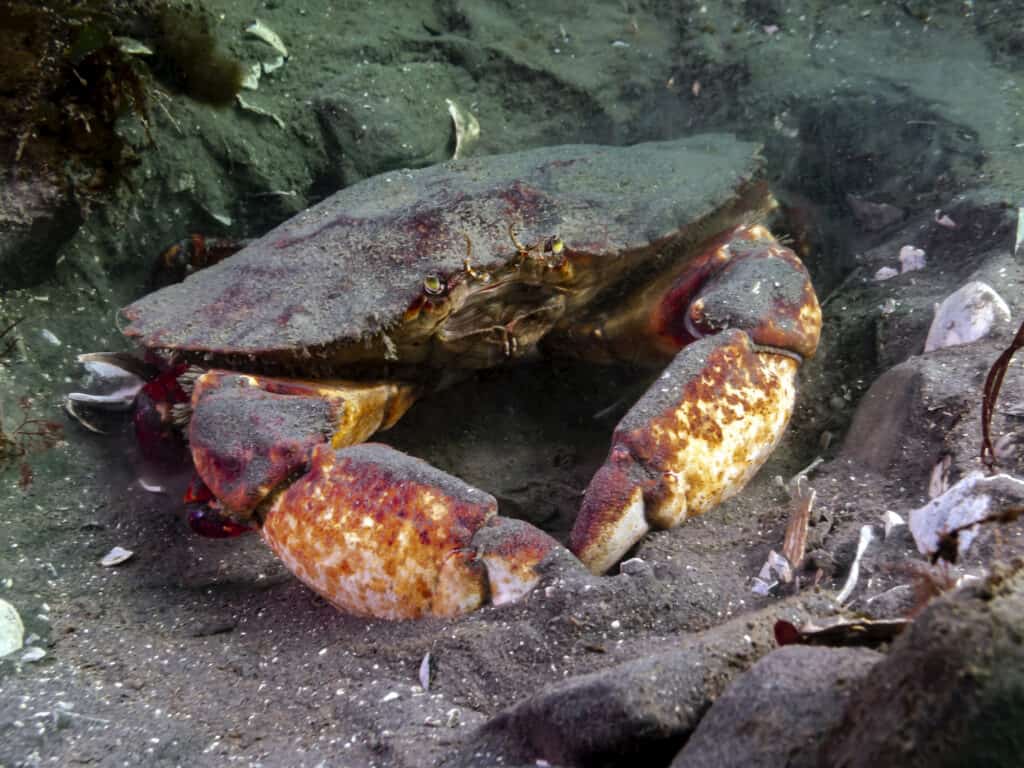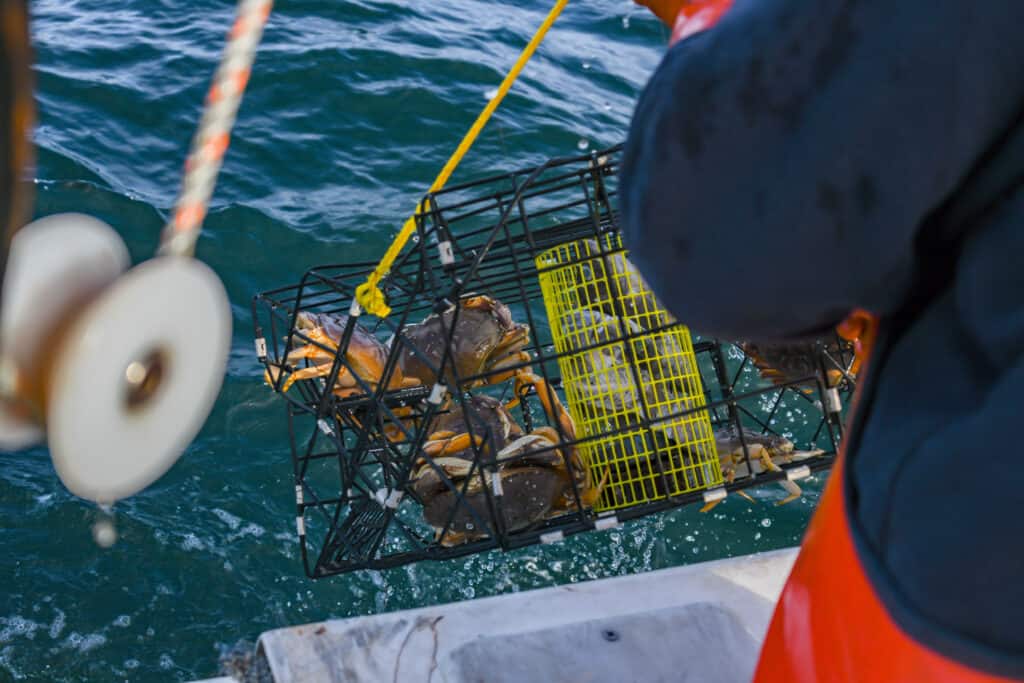Many regions in Washington state have year-long crabbing seasons. But whether you’re crabbing in these spots or those with limited seasons, it’s best to know the regulations like bag limits and size requirements. If you’re interested in trying your hand at Washington crabbing season, the following information will help.
Washington Crabbing Season Timing

The Dungeness crab is one of the three species permitted for crabbing in Washington crabbing season. You’ll find these tasty critters in many locations along the shorelines of the state.
©Ashley-Belle Burns/Shutterstock.com
Timing for Washington crabbing season varies a bit, based on the region, with some year-round and others limited to specific seasons. Some areas usually have crabbing seasons available, but be sure to note some closures until further notice provided by the state.
| Crabbing Area | Status | Days Open | Season Dates |
| South Coast/Pacific Ocean | Open | Everyday | Year-round |
| Columbia River | Open | Everyday | Year-round |
| Westport/Ocean Shores | Open | Everyday | Year-round |
| Willapa Bay – Area 2-1 | Open | Everyday | Year-round |
| Grays Harbor – Area 2-2 | Open | Everyday | Year-round |
| LaPush | Open | Everyday | Year-round |
| Neah Bay – East of Tatoosh-Bonilla line | Open | Everyday | Winter season: Daily from October 1 to December 31. |
| Neah Bay – West of Tatoosh-Bonilla line | Open | Everyday | Year-round |
| Sekiu and Pillar Point | Open | Everyday | Winter season: Daily from October 1 to December 31. |
| East Juan de Fuca Strait, Port Angeles Harbor, Discovery Bay | Open | Everyday | Winter season: Daily from October 1 to December 31. |
| South – San Juan Islands/Bellingham | Open | Everyday | Winter season: Daily from October 1 to December 31. |
| North – Gulf of Georgia | Open | Everyday | Winter season: Daily from October 1 to December 31. |
| Deception Pass – Area 8-1 | Open | Everyday | Winter season: Daily from October 1 to December 31. |
| Port Susan/Everett – Area 8-2 | Open | Everyday | Winter season: Daily from October 1 to December 31. |
| Admiralty Inlet | Open | Everyday | Winter season: Daily from October 1 to December 31. |
| Port Gamble/Port Ludlow | Open | Everyday | Winter season: Daily from October 1 to December 31. |
| Seattle/Bremerton | Closed | None | No winter season currently scheduled. |
| Tacoma-Vashon Island | Closed | None | No winter season currently scheduled. |
| Hood Canal – North of Ayock Point | Open | Everyday | Winter season: Daily from October 1 to December 31. |
| Hood Canal – South of Ayock Point | Closed | None | Closed until further notice. |
| South Puget Sound | Closed | None | Closed until further notice. |
Washington Crabbing Season Species to Keep
There are three species of crabs you may catch and keep in Washington. These are the Dungeness, red rock, and tanner crabs.
Washington Crabbing Season Bag Limits
Three species of crabs may be caught in Washington, each with specific daily bag limits.
Dungeness Crabs

While they prefer shallower water, Dungeness Crabs have been found at depths of two hundred meters. You may catch these crabs in Washington but they must be at least 6.25 inches to keep.
©Jennifer Nicole Buchanan/Shutterstock.com
Dungeness crabs must be at least 6.25 inches to keep. You may bag up to 5 males, retaining shells in the field. Must release all females and undersized crabs, as well as softshell males.
Red Rock Crabs

Red rock crabs, male or female, must be 5 inches or bigger to keep when you go crabbing in Washington.
©iStock.com/naturediver
Red Rock crabs exceeding 5 inches, whether male or female, may be bagged daily. You may keep no more than 6 of these crabs each day and must retain the shell in the field. You must release softshell crabs.
Tanner Crabs

Tanner crabs must be at least 4.5 inches in size before keeping them when crabbing in Washington.
©Shpatak/Shutterstock.com
You may catch up to 6 male or female tanner crabs daily. They must be at least 4.5 inches and must retain their shells in the field. All softshell crabs must be released.
Where in Washington Can You Go Crabbing?
The following areas are open for Washington crabbing season. Check the season notes for when you may go crabbing at each location.
- South Coast/Pacific Ocean
- Columbia River
- Westport/Ocean Shores
- Willapa Bay Area 2—1
- Grays Harbor Area 2—2
- LaPush
- Neah Bay East of Tatoosh-Bonilla line
- Neah Bay West of Tatoosh-Bonilla line
- Sekiu and Pillar Point
- East Juan de Fuca Strait
- Port Angeles Harbor
- Discovery Bay
- South San Juan Islands/Bellingham
- North Gulf of Georgia
- Deception Pass Area 8—1
- Port Susan/Everett Area 8—2
- Admiralty Inlet
- Port Gamble/Port Ludlow
- Seattle/Bremerton
- Tacoma—Vashon Island
- Hood Canal North of Ayock Point
How to Catch Crabs

Most folks use crab traps for Washington crabbing season, but a dip net is easier for beginners.
©Photo_time/Shutterstock.com
Crab traps are most frequently used by crabbers each summer. However, many others opt to catch crabs with a simple dip net (many say this is the easiest method), or even using a fishing rod.
Dip nets are what they sound like: you use them in your hand and dip them into the water to snatch up a crab. If you plan to use a fishing line or crab trap, use smelly bait. Afterall, crabs are scavengers, so they like raw chicken, turkey, fish, and razor clams. Some folks even use human foods like hot dogs to catch these creepers of the deep.
Washington Crabbing Season Regulations and Licenses
Before you hit the water with Washington crabbing in mind, head over first to the licensing offices. You’ll need proper fishing licensure, whether you’re a local or visitor to the state.
- Anyone 15 and older much have a fishing license when crabbing.
- No license is required for common carp, bullfrogs, crawfish, or collecting relic shells.
- You must keep and carry a catch record when fishing. All catch records must be recorded on the cards and returned to the Washington Department of Fish and Wildlife by deadlines listed. Even if you catch nothing, the record must be submitted on time.
- It may take up to 10 days to receive your license if purchased online or by phone. A temporary license may be mailed for use during the period if you register an email address with the Washington Department of Fish and Wildlife.
- If you need a license for immediate use, go to a local license dealer for immediate use.
- You must adhere to the proper seasons for the species you catch and the daily catch limits for each.
The photo featured at the top of this post is © Ashley-Belle Burns/Shutterstock.com
Thank you for reading! Have some feedback for us? Contact the AZ Animals editorial team.






